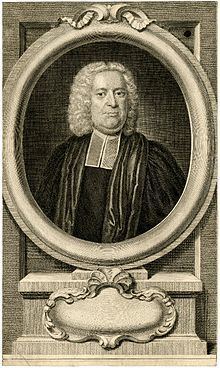Name Thomas Stackhouse | Children Thomas Stackhouse | |
 | ||
Died 1752, Beenham, United Kingdom | ||
Thomas Stackhouse (1677–1752) was an English theologian and controversialist.
Contents
Life
The son of John Stackhouse (d. 1734), who became rector of Boldon in County Durham, and uncle of John Stackhouse, he was born at Witton-le-Wear where his father was then curate. On 3 April 1694 he entered at St. John's College, Cambridge and was B.A. when ordained in 1704; the M.A. which appears on the title-pages of some of his works does not seem to represent a degree from an English university. It was possibly obtained, as the tradition in his family runs, during his residence abroad.
From 1701 to 1704 Stackhouse was headmaster of Hexham Grammar School, and on 28 December 1704 he was ordained priest in London. He then became curate of Shepperton in Middlesex, and from 1713 was minister of the English church at Amsterdam. In 1731 he was curate of Finchley.
For some time Stackhouse lived in poverty. He was rescued by his appointment in the summer of 1733 to the vicarage of Beenham, Berkshire. In 1737 he had a house in Theobald's Court, London; in 1741 he was living at Chelsea.
Stackhouse died at Beenham on 11 October 1752, and was buried in the parish church, with a large interior monument.
Works
The major work of Stackhouse was his New History of the Holy Bible from the Beginning of the World to the Establishment of Christianity, which he brought out in numbers from 1733 and then published in three folio volumes in 1737. The genesis of the work was with two booksellers, John Wilford and Thomas Edlin; Stackhouse wrote a pamphlet about them. A second edition came out in numbers in 1742–4, and was published in two folio volumes, with a dedication to his patron, Bishop Edmund Gibson. It was then often reprinted, with additional notes, by other divines. John Trusler compiled from it in 1797 A Compendium of Sacred History.
In 1722, as "A Clergyman of the Church of England", addressed a printed letter to Bishop John Robinson, on the "miseries and great hardships of the inferiour clergy in and about London2. It was reissued, and the later editions had his name on the title-page.
Besides sermons, Stackhouse published:
Stackhouse added to the third volume of the works of Archbishop William Dawes a supplement of a course of devotions. He is sometimes credited with the authorship of The Art of Shorthand on a New Plan, by "Thomas Stackhouse, A.M." [1760?].
Family
By his first wife, who died in 1709, Stackhouse had two sons, and by his second wife, Elizabeth Reynell, two sons and one daughter. Thomas Stackhouse, M.A. (1706–1784), the younger son by his first wife, married Hester Nash (d. 1794) in 1767, and died at Lisson Grove, London, in 1784. He wrote:
